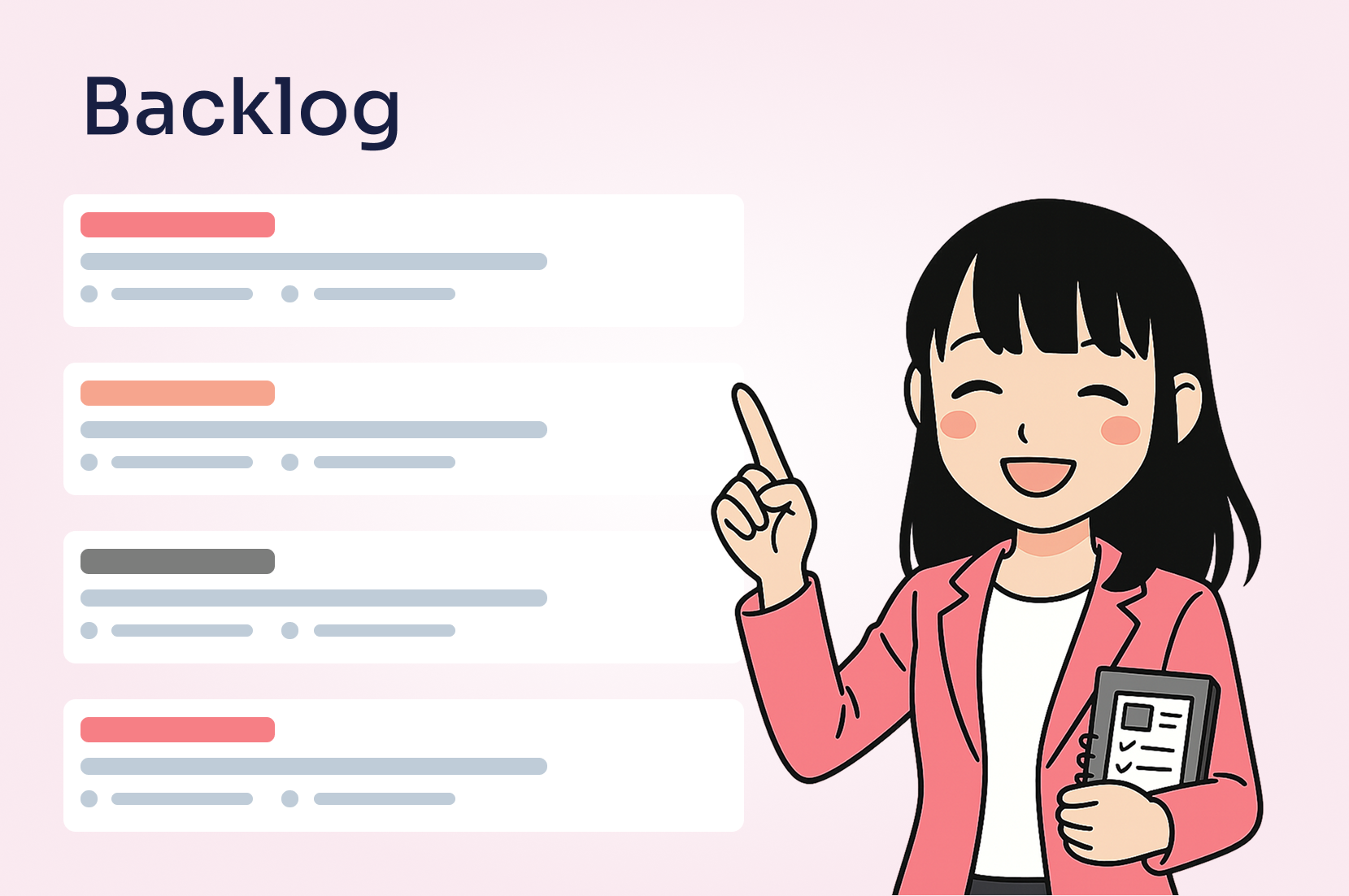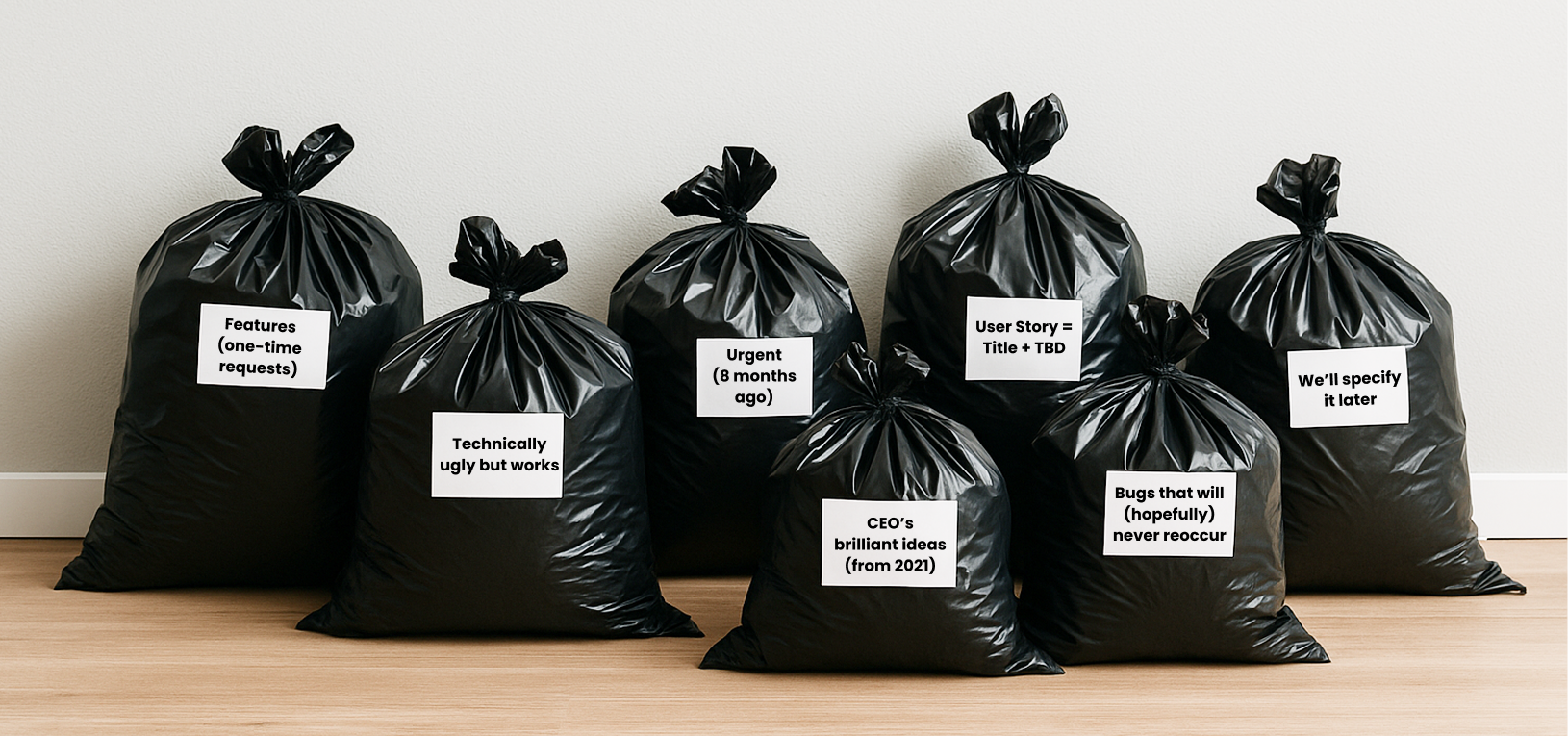Tidy Up Your Backlog With Marie Kondo: 6 Principles for More Focus

Backlog = Digital Junk Room?
The backlog — also known in many teams as the digital junk room. Almost nobody likes spending time in there. Be honest: you probably just open it quickly, hope nothing jumps out, and stuff in whatever you want to get rid of. Tons of tickets, old ideas, open bugs, feature requests from two years ago – everything is in there, nothing is sorted. You scroll, you search, and you lose track.
Eventually, it gets so full that someone says: “Time for a clean-up.” So you all suffer through it once – and hope it’ll be enough for a while. But cleaning up the backlog should be more than that. Because your backlog is one of the most important tools in your product development.
If your backlog also feels like a messy storage room: you’re not alone. That’s totally normal, especially in fast-growing teams that want to get a lot done. Still, a chaotic backlog costs focus, drains energy, and makes strategic work harder.
How Marie Kondo changed tidying up – and why her method works for your backlog too
Most people don’t enjoy cleaning – whether it’s the backlog, your apartment, or the attic. Maybe you’ve heard of Marie Kondo? The Japanese organizing expert became famous for her books and Netflix show Tidying Up with Marie Kondo. Her message: If you tidy up with structure and consistency, you create space – in your home, in your head, and in your life.
And it seems to work! I mean… people could watch a rom-com, an action thriller, or the next season of their favorite show. But they choose to watch someone clean – and then even turn off the TV to do it themselves. Her method works.
Her approach is more than just a bit of sorting. It’s about letting go of clutter, making conscious decisions, and keeping only what really matters. Sounds like a lifestyle thing? Not at all. She follows six simple principles – and they apply directly to your backlog.
Six Steps to a Cleaner Backlog
Here’s how you can apply Marie Kondo’s principles to your backlog. A lot of this won’t be new to you – but use these 6 steps as a guide for your next clean-up session. It’s easier than you think.
1. Does it spark joy?
Marie Kondo asks one simple question for every item: “Does it spark joy?” It’s not as cheesy as it sounds – it’s about making clear decisions. In product management, the real question is: Does this bring value?
Look at each ticket and ask: Does this help our users or the business? If not – delete it. Be ruthless. Some tickets look harmless but eat up time and attention. A backlog is not a wish list – it’s a planning tool.
Example: Dark mode for the admin panel? Nice idea. But if nobody asked for it in three years, no users need it, and there’s no real benefit – delete it.
2. Clean by category (i.e. ticket type)
A common mistake when tidying: sorting by location. If you clean room by room, you handle the same items again and again without getting the full picture. Marie Kondo says: If you clean the bedroom today, the living room tomorrow, and the storage room the next day, you’ll sort out a few books each time – but probably not enough. You don’t know what you really have and end up keeping too much.
Same for the backlog: If you go through everything randomly, you jump between ticket types and lose focus. Stick to one category at a time. That helps avoid blind spots, duplicates, and wrong priorities.
Start with all bugs, then go through feature ideas, then technical tasks – or whatever order works for you.
3. Put everything in one pile
Before you decide what stays, you need to see what’s there. Marie Kondo asks people to put all their clothes in one pile – to show how much they really own.
In your backlog, this means: bring the old stuff to the top. Filter for anything older than six months or tickets that were never prioritized. Go through these one by one. You’ll be surprised how much of it you can delete right away.
4. Declutter first, then organize
Many teams try to fix a messy backlog by adding structure: labels, epics, workflows. But like Marie Kondo says: clean first, then organize. Adding structure to a pile of junk still gives you junk.
Linking 42 old user stories to an epic doesn’t help – if no one needs that feature. First get clarity, then bring in order.

5. Everything needs a proper place
Everything you keep needs a home. If things lie around, chaos grows. Good structure saves energy in the long run – because you don’t have to search.
Your backlog also needs structure:
- Which epic does this user story belong to?
- Who owns the ticket?
- What’s the current status?
Every ticket needs a clear status, a responsible person, a goal, and a description. If anything is missing, the ticket will just sit there – or create confusion.
6. Let go with respect
Marie Kondo doesn’t just throw things away – she lets them go with intention. The idea: something served its purpose, and now it’s time to move on. Deleting isn’t a loss – it’s clarity.
Same for your backlog: you can delete tickets. If something matters, it will come back. Still, we often hesitate – out of politeness, nostalgia, or uncertainty. Maybe you see who had created the ticket. Or maybe the topic used to be important. But holding on doesn’t help. Try writing a short comment explaining why you’re closing it.
- “Not implemented – turned out to be less relevant during user interviews.”
- “Was discussed internally, but currently not prioritized. Can be reopened if needed.”
- “Original idea is now covered by feature X.”
That way, everyone on the team knows why a decision was made and you avoid repeating discussions.
One Last Thing: Just Reading This Won’t Clean Your Backlog
So far, it was probably easy to agree with all this. You know we’re right: a tidy backlog feels good. You find things faster. You make better decisions. Your team knows what’s going on. And your mind is free for what really matters.
But let’s be honest: reading a blog post won’t clean your backlog. Now comes the hard part – actually doing it.
Worried we are leaving you to do it alone?
Of course not.
If you don’t want to clean your backlog all by yourself, check out the Product Copilot – an AI tool we built just for this. It helps you clean up your Jira backlog by spotting duplicates, keeping tickets up to date, and bringing order to the chaos. And you don’t need to spend hours doing it manually.